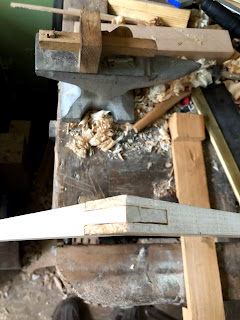A few years back, I found an old violin in a sorry state and simply used it as decoration in the living room. Then in Spring 2017 I decided to bring it back to life...
The violin is a 19th century German copy of a Nicolaus Amatus violin that had a rough life. They're supposed to be good student violins.
Using a thin scraper, I popped the top open and started inspecting the extent of the damage. Three corner blocks were missing, so I started making new ones from straight grain fir I had stashed away.
Cut close to fit
The usual 'Nicolaus Amatus fecit in Cremona 184?' label from the 19th century copies made in Markneukirchen or Mittenwald.
It also had this hand-written note inside, stating that it had been repaired in 1904. I guess that's when the label got partially rewritten by hand.
The whole thing was covered in dust, and the nut was missing.
The top was in 4 parts
Starting to glue the top back together, adding patches of thin straight-grained fir.
Getting the corner blocks closer to the correct size
Using a round plane upside-down in the vise helped shaping the corner blocks
Shaving the patches down with a very sharp chisel.
It looks like it's put back correctly.
A few steps later, the top is back in one piece, on the right you can see the fingerboard
Fitting and gluing the third corner block
Clamping the top back on, I know those aren't the correct clamps for the task but I didn't use any pressure.
The fingerboard glued back in place... notice my very traditional hot glue pot on the right. For the entire project, I have used a mix of hide glue and bone glue.
And there it is, almost done. A couple coats of boiled linseed oil followed by a couple coats of shellac and it's looking nicer. I've ordered the missing parts and I'll finish the violin when they get here...
I received the parts a few days later... 2017 ended, 2018 ended, ...
Fast forward to this morning where I suddenly decided to finish it. I fitted the bridge, strung the violin, added rosin to the bow and tried it. Notice I didn't say 'set the sound post' because I wasn't able to do it yet. It pops out of the setter when I try to wedge it in position.
A new custom nut in rosewood, new strings, fine tuners on the tail piece...
Surprisingly, it plays and sounds rather nice. Setting the sound post would improve the sound and especially the volume. So far, it is staying tuned and I was able to play a basic scale on it. Next... twinkle twinkle little star. Did I mention it is actually the first time I pick up a bow and play the violin?





















































